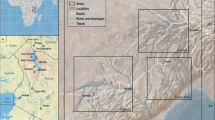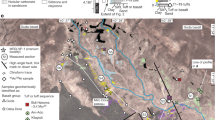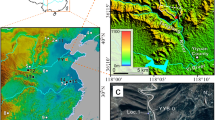Abstract
Several phyletic lines of Elephantidae were derived from a common gomphotheriid ancestor in the late Pliocene of Africa. These lines evolved at different rates, passing through similar stages at different times as reflected in the morphology of the molar teeth. Comparisons of the many remains of fossil elephants in sediments of Plio-Pleistocene age in Africa allow a lineage specific identification of the fossils and thus provide a means of stratigraphically correlating these deposits.
This is a preview of subscription content, access via your institution
Access options
Subscribe to this journal
Receive 51 print issues and online access
$199.00 per year
only $3.90 per issue
Buy this article
- Purchase on Springer Link
- Instant access to full article PDF
Prices may be subject to local taxes which are calculated during checkout
Similar content being viewed by others
References
Cooke, H. B. S., Quart. Rev. Biol., 43, 234 (1968).
Coppens, Y., CR Acad. Sci., Paris, 251, 2385 (1960).
Coppens, Y., Proc. Fifth Pan-Afr. Prehist. Congr., 331 (1965).
Aguirre, E., Science, 164, 1366 (1969).
Hooijer, D. A., Zool. Meded. Mus., Leiden, 33, 103 (1954).
Petrocchi, C., Boll. Soc. Geol. Ital., 60, 107 (1941).
Maglio, V. J., Breviora (in the press).
Patterson, B., Nature, 212, 577 (1966).
Patterson, B., and Howell, W. W., Science, 156, 64 (1967).
Cooke, H. B. S., and Coryndon, S., in Fossil Vertebrates of Africa, 2 (1969, in the press).
Meiring, A. D. J., Researches Nat. Mus. Bloemfontein, 1, 187 (1955).
MacInnes, D. G., Trans. Zool. Soc., Lond., 25, 33 (1942).
Cooke, H. B. S., Palaeont. Afr., 7, 64 (1960).
Arambourg, C., Bull. Mus. Nat. Hist. Nat., Paris, ser. 2, 24, 407 (1952).
Hoijer, D. A., Leid. Geol. Meded., 20, 110 (1955).
Savage, D. E., and Curtis, G. H., Proc. Soc. Econ. Paleont. Min. Res. Comm. Symp. (1968) (in the press).
Butzer, K. W., and Thurber, D. L., Nature, 222, 1138 (1969).
Howell, F. C., Nature, 219, 567 (1968).
Dietrich, W. O., Palaontographica, 94, 43 (1942).
Maglio, V. J., Breviora, No. 336 (1969).
Leakey, L. S. B., Olduvai Gorge 1951–1961, 1 (Cambridge Univ. Press., London, 1965).
Dart, R. A., S. Afr. J. Sci., 26, 698 (1929).
Hopwood, A. T., in The Prehistory of Uganda Protectorate (edit. by O'Brien, T. P.), 308 (Cambridge, 1939).
Arambourg, C., Mission Scient. Omo, 1932–1933, 1, 232 (1947).
Author information
Authors and Affiliations
Rights and permissions
About this article
Cite this article
MAGLIO, V. Early Elephantidae of Africa and a Tentative Correlation of African Plio-Pleistocene Deposits. Nature 225, 328–332 (1970). https://doi.org/10.1038/225328a0
Received:
Revised:
Published:
Issue Date:
DOI: https://doi.org/10.1038/225328a0
Comments
By submitting a comment you agree to abide by our Terms and Community Guidelines. If you find something abusive or that does not comply with our terms or guidelines please flag it as inappropriate.



